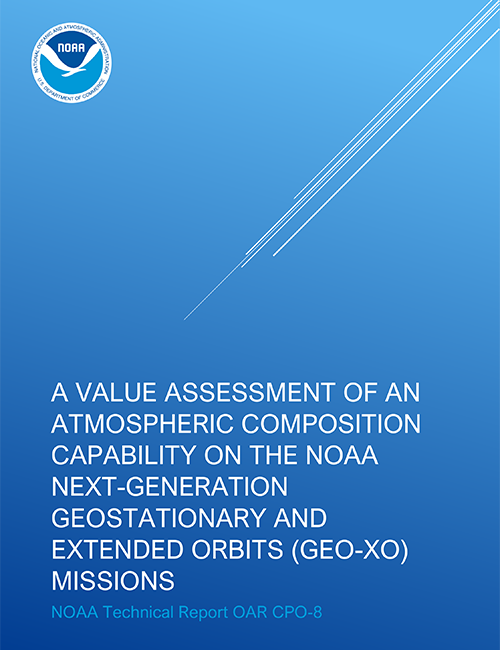A .gov website belongs to an official government organization in the United States.
A lock () or https:// means you've safely connected to the .gov website. Share sensitive information only on official, secure websites.
5 November 2020
adapted from the story by NOAA CPO Communications

Commissioned by the NOAA GEO-XO Program, this technical report assesses the value of atmospheric composition (AC) products from the next generation of the NOAA operational geostationary and extended orbits (GEO-XO) satellites to be launched between 2030 and 2050. Reflecting the assessment of a large team of NOAA scientific, technical, and operational experts, the report is the starting point for a longer-term, comprehensive examination of the value of AC observations for NOAA's operational GEO capabilities. CSL's Greg Frost led the report's production team, which included CSL's Owen Cooper, Audrey Gaudel, Brian McDonald, and Karen Rosenlof.
AC, encompassing the vertical and geographical distribution of all gas phase trace chemical constituents and aerosols, plays pivotal roles in air quality, weather, and climate, both directly and via complex Earth System feedbacks. As the month-long dust storms and record-breaking wildfires of 2020 attest, AC can also dramatically affect life and property.
The report identifies NOAA mission requirements, stakeholder mandates, and seven science and operational application areas that will benefit from one or more GEO satellite instruments providing AC products at high temporal frequency and spatial resolution. Those seven areas are: (1) Air Quality Forecasting, (2) Weather and Climate Forecasting, (3) Fire Weather Forecasting, (4) Hazards Forecasting, (5) Stratospheric Ozone Monitoring, (6) Greenhouse Gas Monitoring, and (7) Air Quality Monitoring.
Frost, G.J., M. Kopacz, S. Kondragunta, R. Ahmadov, J. Al-Saadi, A. Andrews, C. Barnet, V. Breeze, J. Christopoulos, O. Cooper, A. Crawford, L. Flynn, A. Gaudel, C. Martin, B. McDonald, J. McQueen, F. Paulot, M. Pavolonis, I. Petropavlovskikh, R.B. Pierce, K.H. Rosenlof, R. Saylor, T. Schmit, I. Stajner, D. Stanitski, and J. Szykman, A Value Assessment of an Atmospheric Composition Capability on the NOAA Next-Generation Geostationary and Extended Orbits (GEO-XO) Missions, NOAA Technical Report OAR CPO 8, doi:10.25923/1s4s-t405, 2020.
This document assesses the value of atmospheric composition products from the next generation of the National Oceanic and Atmospheric Administration (NOAA) operational geostationary and extended orbits (GEO-XO) satellites to be launched between 2030 and 2050. Atmospheric Composition (AC) encompasses the vertical and geographical distribution of all gas phase trace chemical constituents (i.e., <<1% by number or mass of the atmosphere) and aerosols. AC plays pivotal roles in air quality, weather, and climate, both directly and via complex Earth System feedbacks. Further, as the month-long dust storms, record-breaking wildfires, and COVID-19 pandemic related mobility restrictions in 2020 have made startlingly evident, AC can dramatically affect life and property.